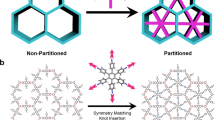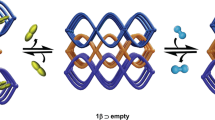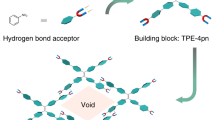Abstract
Introducing a functional part into open-framework materials that tunes the pore size/shape and overall porous activity will open new routes in framework engineering and in the fabrication of new materials. We have designed and synthesized a bimodal microporous twofold interpenetrating network {[Ni(bpe)2(N(CN)2)](N(CN)2)(5H2O)}n (1), with two types of channel for anionic N(CN)2− (dicyanamide) and neutral water molecules, respectively. The dehydrated framework provides a dual function of specific anion exchange of free N(CN)2− for the smaller N3− anions and selective gas sorption. The N3-exchanged framework leads to a dislocation of the mutual positions of the two interpenetrating frameworks, resulting in an increase in the effective pore size in one of the counterparts of the channels and a higher accommodation of adsorbate than in the as-synthesized framework (1), showing the first case of controlled sorption properties in flexible porous frameworks.
This is a preview of subscription content, access via your institution
Access options
Subscribe to this journal
Receive 12 print issues and online access
$259.00 per year
only $21.58 per issue
Buy this article
- Purchase on Springer Link
- Instant access to full article PDF
Prices may be subject to local taxes which are calculated during checkout






Similar content being viewed by others
References
Kitagawa, S., Kitaura, R. & Noro, S. I. Functional porous coordination polymers. Angew. Chem. Int. Edn 43, 2334–2375 (2004).
Yaghi, O. M. et al. Reticular synthesis and the design of new materials. Nature 423, 705–714 (2003).
Bradshaw, D., Claridge, J. B., Cussen, E. J., Prior, T. J. & Rosseinsky, M. J. Design, chirality, and flexibility in nanoporous molecule-based materials. Acc. Chem. Res. 38, 273–282 (2005).
Férey, G., Mellot-Draznieks, C., Serre, C. & Millange, F. Crystallized frameworks with giant pores: Are there limits to the possible? Acc. Chem. Res. 38, 217–225 (2005).
Janiak, C. Engineering coordination polymers towards applications. Dalton Trans. 2781–2804 (2003).
Férey, G. et al. A chromium terephthalate-based solid with unusually large pore volumes and surface area. Science 309, 2040–2042 (2005).
Rowsell, J. L. C. & Yaghi, O. M. Strategies for hydrogen storage in metal–organic frameworks. Angew. Chem. Int. Edn 44, 4670–4679 (2005).
Noro, S. I., Kitagwa, S., Kondo, M. & Seki, K. A new, methane adsorbent, porous coordination polymer [{Cu(SiF6)(4,4′-bipyridine)2]n . Angew. Chem. Int. Edn 39, 2082–2084 (2000).
Kondo, M., Yoshitomi, T., Seki, K., Matsuzaka, H. & Kitagawa, S. Three-dimensional framework with channeling cavities for small molecules: {[M2(4,4′-bpy)3(NO3)4].xH2O}n (M=Co, Ni, Zn). Angew. Chem. Int. Edn 36, 1725–1726 (1997).
Ohmori, O. & Fujita, M. Heterogeneous catalysis of a coordination network: cyanosilylation of imines catalyzed by a Cd(II)-(4,4′-bipyridine) square grid complex. Chem. Commun. 1586–1587 (2004).
Wu, C.-D., Hu, A., Zhang, L. & Lin, W. A homochiral porous metal–organic framework for highly enantioselective heterogeneous asymmetric catalysis. J. Am. Chem. Soc. 127, 8940–8941 (2005).
Chang, J.-S. et al. Nanoporous metal containing nickel phosphates: A class of shape selective catalyst. Angew. Chem. Int. Edn 43, 2819–2822 (2004).
Seo, J. S. K. et al. A homochiral metal–organic porous material for enantioselective separation and catalysis. Nature 404, 982–986 (2000).
Pan, L., Olson, D. H., Ciemnolonski, L. R., Heddy, R. & Li, J. Separation of hydrocarbons with a microporous metal–organic framework. Angew. Chem. Int. Edn 45, 616–619 (2006).
Min, K. S. & Suh, M. P. Silver(I)-polynitrile network solids for anion exchange: Anion-induced transformation of supramolecular structure in the crystalline state. J. Am. Chem. Soc. 122, 6834–6840 (2000).
Halder, G. H., Kepert, C. J., Moubaraki, B., Murray, K. S. & Cashion, J. D. Guest dependent spin crossover in a nanoporous molecular framework material. Science 298, 1762–1765 (2002).
Kitaura, R., Seki, K., Akiyama, G. & Kitagawa, S. Porous coordination-polymer crystals with gated channels specific for supercritical gases. Angew. Chem. Int. Edn 42, 428–431 (2003).
Seki, K. Dynamic channels of a porous coordination polymer responding to external stimuli. Phys. Chem. Chem. Phys. 4, 968–1971 (2002).
Lee, E. Y., Jang, S. Y. & Suh, M. P. Multifunctionality and crystal dynamics of a highly stable, porous metal–organic framework [Zn4O(NTB)2]. J. Am. Chem. Soc. 127, 6374–6381 (2005).
Biradha, K. & Fujita, M. A spring like 3D-coordination network that shrinks or swells in a crystal-to-crystal manner upon guest removal or readsorption. Angew. Chem. Int. Edn 41, 3392–3395 (2002).
Matsuda, R. et al. Guest shape-responsive fitting of porous coordination polymer with shrinkable framework. J. Am. Chem. Soc. 126, 14063–14070 (2004).
Cussen, E. J., Claridge, J. B., Rosseinsky, M. J. & Kepert, C. J. Flexible sorption and transformation behavior in a microporous metal–organic framework. J. Am. Chem. Soc. 124, 9574–9581 (2002).
Bourrelly, S. et al. Different adsorption behaviors of methane and carbon dioxide in the isotypic nanoporous metal terephthalates MIL-53 and MIL-47. J. Am. Chem. Soc. 127, 13519–13521 (2005).
Reineke, T. M., Eddaoudi, M., Moler, D., O’Keeffe, M. & Yaghi, O. M. Large free volume in maximally interpenetrating networks: The role of secondary building units exemplified by Tb2(ADB)3[(CH3)2SO]4.16[(CH3)2SO]. J. Am. Chem. Soc. 122, 4843–4844 (2000).
Chen, B., Eddaoudi, M., Hyde, S. T., O’Keeffe, M. & Yaghi, O. M. Interwoven metal–organic framework on a periodic minimal surface with extra large pores. Science 291, 1021–1023 (2001).
Kesanli, B. et al. Highly interpenetrated metal–organic frameworks for hydrogen storage. Angew. Chem. Int. Edn 44, 72–75 (2005).
Matsuda, R. et al. Highly controlled acetylene accommodation in a metal–organic microporous material. Nature 436, 238–241 (2005).
Kuznicki, S. M. et al. A titanosilicate molecular sieve with adjustable pores for size-selective adsorption of molecules. Nature 412, 720–723 (2001).
Dinca, M. & Long, J. R. Strong H2 binding and selective gas adsorption within the microporous coordination solid Mg3(O2C-C10H6-CO2)3 . J. Am. Chem. Soc. 127, 9376–9377 (2005).
Dybtsev, D. N., Chun, H., Yoon, S. H., Kim, D. & Kim, K. Microporous manganese formate: A simple metal–organic porous material with high framework stability and high selective gas sorption properties. J. Am. Chem. Soc. 126, 32–33 (2004).
Pan, L. et al. Porous lanthanide-organic frameworks: Synthesis, characterization, and unprecedented gas adsorption properties. J. Am. Chem. Soc. 125, 3062–3067 (2003).
Maji, T. K., Uemura, K., Chang, H.-C., Matsuda, R. & Kitagawa, S. Expanding and shrinking porous modulation based on pillared-layer coordination polymers showing selective guest adsorption. Angew. Chem. Int. Edn 43, 3269–3272 (2004).
Muthu, S., Yip, J. H. K. & Vittal, J. J. Coordination network of Ag(I) and N, N′-bis(3-pyridine-carboxamide)-1,6-hexane: Structure and anion exchange. J. Chem. Soc. Dalton Trans. 4561–4568 (2002).
Lee, E., Kim, J., Heo, J., Whang, D. & Kim, K. A two dimensional polyrotaxane with large cavities and channels: A novel approach to metal–organic open-frameworks by using supramolecular building blocks. Angew. Chem. Int. Edn 40, 399–402 (2001).
Kurmoo, M., Kumagai, H., Hughes, S. M. & Kepert, C. J. Reversible guest exchange and ferrimagnetism (T c=60.5 K) in a porous cobalt(II)-hydroxide layer structure pillared with trans-1,4-cyclohexanedicarboxylate. Inorg. Chem. 42, 6709–6722 (2003).
Guillou, N., Livage, C., Drillon, M. & Férey, G. The chirality, porosity, and ferromagnetism of a 3D nickel glutarate with intersecting 20-membered ring channels. Angew. Chem. Int. Edn 42, 5314–5317 (2003).
Abrahams, B. F., Batten, S. R., Hamit, H., Hoskins, B. F. & Robson, R. A cubic (3,4)-connected net with large cavities in solvated [Cu3(tpt)4](ClO4)3 (tpt=2,4,6-Tri(4-pyridyl)-1,3,5-triazine). Angew. Chem. Int. Edn Engl. 35, 1690–1692 (1996).
Tong, M. L. et al. A novel three-dimensional coordination polymer constructed with mixedvalence dimeric copper(I,II) units. Chem. Commun. 428–429 (2003).
Webster, C. E., Drago, R. S. & Zerner, M. C. Molecular dimensions for adsorptives. J. Am. Chem. Soc. 120, 5509–5516 (1998).
Beck, D. W. Zeolite Molecular Sieves (Wiley, New York, 1974).
Llewellyn, P. L., Bourrelly, S., Serre, C, Filinchuk, Y. & Férey, G. How hydration drastically improves adsorption selectivity for CO2 over CH4 in the flexible chromium terephthalate MIL-53. Angew. Chem. Int. Edn 45, 7751–7754 (2006).
Rather, B. & Zaworotko, M. J. A 3D metal–organic network, [Cu2(glutarate)2(4,4′-bipyridine)], that exhibits single-crystal to single-crystal dehydration and rehydration. Chem. Commun. 830–831 (2003).
Takaoka, K., Kawano, M., Tominaga, M. & Fujita, M. In-situ observation of a reversible single-crystal-to-single-crystal apical-ligand-exchange reaction in hydrogen-bonded 2D coordination network. Angew. Chem. Int. Edn 44, 2151–2154 (2005).
Lee, E. Y. & Suh, M. P. A robust porous material constructed of linear coordination polymer chains: Reversible single-crystal-to-single-crystal transformation upon dehydration and rehydration. Angew. Chem. Int. Edn 43, 2798–2801 (2004).
Acknowledgements
This work was supported by Grants-in-Aid for Scientific Research in a Priority Area ‘Chemistry of coordination space’ (434) and a CREST/JST programme from the Ministry of Education, Culture, Sports, Science and Technology, Government of Japan.
Author information
Authors and Affiliations
Corresponding author
Ethics declarations
Competing interests
The authors declare no competing financial interests.
Supplementary information
Supplementary Information, Fig S1
Supplementary Information; Figures S1-S8; Tables S1, S2 (PDF 1055 kb)
Rights and permissions
About this article
Cite this article
Maji, T., Matsuda, R. & Kitagawa, S. A flexible interpenetrating coordination framework with a bimodal porous functionality. Nature Mater 6, 142–148 (2007). https://doi.org/10.1038/nmat1827
Received:
Accepted:
Published:
Issue Date:
DOI: https://doi.org/10.1038/nmat1827
This article is cited by
-
Diverse crystal size effects in covalent organic frameworks
Nature Communications (2020)
-
Anisotropic reticular chemistry
Nature Reviews Materials (2020)
-
Regulation of the Degree of Interpenetration in Metal–Organic Frameworks
Topics in Current Chemistry (2020)
-
Semiconductivity and superhydrophobicity in an oligo-(p-phenyleneethynylene) (OPE)-based luminescent MOF
Bulletin of Materials Science (2020)
-
Direct synthesis of Zn(II) and Cu(II) coordination polymers based on 4,4′-bipyridine and 1,10-phenanthroline and evaluating their effects as catalyst on ammonium perchlorate thermal decomposition
Journal of Thermal Analysis and Calorimetry (2020)



